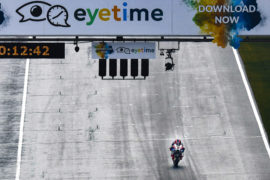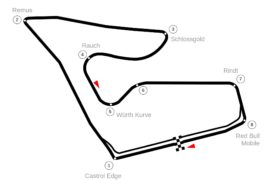MotoGP is fated not to escape the influence of the weather this season. There has barely been a race which has not been affected in one way or another. Even when it hasn’t rained, it has been stiflingly hot, sizzling tracks causing tires to wilt. So why should things be any different at Misano?
Heavy overnight rain left the track still spotty and damp in patches in the morning, Moto3 getting the worst of it, MotoGP just being left to deal with the occasional stubborn spot of dampness where the water took longer to dry.
It caused a spate of crashes in the morning, and though the track dried nicely and blue skies dominated, it was cooler than normal. When Marc Márquez tried the hardest front tire, that proved just a little too critical, the Repsol Honda rider washing out the front in the final corner.
The rain had also washed any residual rubber from the track, radically altering the grip level. That was a major setback for the factories which had tested at Misano prior to Silverstone, in preparation for this Grand Prix.
“The feeling is completely different than at the test,” Aleix Espargaro complained. “It looks like all the settings we had were not working. The grip is completely different. No grip at all. It feels like ice.”
Testing Is Not Racing
Andrea Dovizioso was not surprised. “It’s like every year,” the championship leader said. Ducati had also tested at Misano, but Dovizioso remained realistic about the value of the test.
“Every year, the same thing happens. The test is very hot, the grip is very good, and the warm up of the tire is perfect. But in these conditions, there was a lot of rain so there is no rubber on the ground, and the air is a little bit colder and the tire takes more laps to be ready.”
“So it’s normal to have this condition, and it’s more difficult to make the lap time and get the feeling. In the test, with hot temperatures, you are able to be very fast on the out lap, today not. But it’s not something new, we have to adapt to the situation of the weekend. It’s the same for everybody.”
Were the tests done by Aprilia, Ducati, Honda, KTM, and Yamaha a waste of time? Though the riders universally bemoaned the lack of grip at the track, it had still had some benefits.
“Well, it’s always useful because you already know the track well, and you know the problems,” Maverick Viñales summed up on Friday afternoon. But the setting changes found were not much use on a cool track with very little grip.
“It confused me because the grip was so good [at the test] that you don’t have to put so much on the gas, because you could use so much speed through the corners. Today the speed in the corners was so difficult because the handling of the bike is not the same as the test.”
The lack of grip was also apparent in the times. At the test, the fastest guys had been lapping in the 1’32s, which would put them well under lap record pace. But despite sunny skies, the best the top riders could manage was the low 1’33s, four tenths or more above the lap record.
The hope is that Saturday, which promises to be much warmer after a night free of rain, will bring much better conditions. If the rubber laid down on Friday is still there on Saturday morning, lap times should drop rapidly, and setup solutions found at the test may once again become applicable to the conditions.
Different Circumstances, Usual Suspects
Despite the complaints about how different the conditions are to the test, the eight fastest riders had all tested here earlier this year. Danilo Petrucci surprised the field by being fastest, the Pramac Ducati rider having test at Misano back during the summer break.
But from Maverick Viñales back to Jorge Lorenzo in eighth, seven riders from three factories – Movistar Yamaha’s Viñales, the Repsol Honda squad of Marc Márquez and Dani Pedrosa, Cal Crutchlow, who also tested with the Repsol riders, and the three factory Ducatis of Andrea Dovizioso, Jorge Lorenzo, and test rider Michele Pirro – had all spent a day riding round Misano three weeks ago.
Pirro is different, of course, as the Ducati test rider has thousands of laps around both Misano and Mugello, the two tracks the Italian factory does most of its testing at.
Times were close, too. Just 0.383 separated Petrucci from Lorenzo, and nine tenths of a second covered the first fifteen riders. A closer look at the lap times shows Dani Pedrosa to be the man with the strongest pace, especially with the harder rear tire, which is likely to be the race tire if it stays dry.
Teammate Marc Márquez looks strong too, though his crash made determining his pace difficult. Andrea Dovizioso is the other man looking sharp after Friday, like the Repsol Hondas, capable of banging out multiple laps in the 1’33s.
Ever sanguine, Dovizioso warned not to read too much into the times. “Like most of the time, after Friday we speak a lot about the result on Sunday, but we have to speak after Saturday,” the championship leader said.
“I think we confirmed a good base, and I’m happy how we started today, but I believe Honda are really competitive, Maverick is competitive, so tomorrow will be an important day to understand really the speed of the competitors. I think we are a little bit better than last year, but not so much.”
A Competitive Ducati?
But it is clear that the Ducati is a better bike than it was. “We knew from the beginning of the year that we cannot make comparison to last year,” Danilo Petrucci explained.
“For example, I think Barcelona was the most incredible race for us because last year me and Dovi arrived 40 and 43 seconds from the lead. This year Dovi won and I crashed two laps to go when I was fourth. Silverstone was the same – a very difficult track for Ducati and Dovi won again.”
Misano appears to confirm that the GP17 is a major step forward for Ducati. “For sure it’s a lot of things,” Petrucci said.
“We are using the bike very differently. I think me, Dovi and Lorenzo are pushing each other. The limit, we put the limit every time further away. Dovi knows the bike very well. Me too for sure. Jorge is a great rider and is discovering the bike week-by-week. We spend a lot of effort during this winter – Ducati, first of all.”
Misano is also a track where the new fairing makes a significant difference. Andrea Dovizioso, who has resisted using the new fairing, not liking the added physicality required to make the bike change direction with the aerodynamic package fitted, admitted he was considering using it at the track.
“I think maybe I’m the best rider in Ducati at using the standard fairing, and I think we have a few positive things from that fairing,” Dovizioso said. “We are trying to use that one, because we did a lot of good races.”
Turning an Aerodynamic Corner?
But Misano could be different, he explained. “We know that this track requests the way of the new fairing, but it’s always a balance. Like always, it’s not easy and it’s impossible to make the right test comparison during the weekend race.”
“We did in the test one month ago, but it was very similar, the final result was very similar. So after a good result in Silverstone, we decided to start like this. But now we will study all the data from the other Ducati riders, because three fast riders used the new fairing, and after we will decide if we will put the new fairing or not.”
Petrucci explained where the aero package caused problems. “With the fairing it’s very heavy, and when you go into one corner you have to think about the next corner immediately,” he said.
“You cannot correct the line and if you miss the line in one corner… For example, in the first three corners, if you brake too much at the first corner, you go wide in the second and third is the same. With this bike it’s difficult to correct the line with the new fairing.”
“For sure, in the second part of the circuit in the long braking area and in acceleration and the fast corners and the last part of the track, we are more competitive with the new fairing. But in the change of direction the bike is like a truck. It’s very, very heavy to move.”
Impersonation Is the Sincerest Form of Flattery
Aprilia’s new fairing, apparently modeled on Ducati’s, does not suffer the same difficulties, according to Aleix Espargaro. “In the test here we tried last year’s winglets and I liked it a lot,” the Spaniard said.
“So I tried to push the engineers to make a new fairing, but just covering last year’s winglets. They did a really great job in just ten days and the fairing is fantastic. I really like it a lot. I improve a lot the feeling especially in the fast corners with this fairing.”
It was a radical improvement over the previous version, he said. “I re-tried the ‘evo’ fairing and it makes it the bike super heavy and we lose top speed,” Espargaro said.
“I asked the engineers to bring back the wings for the test here in Misano and from the beginning I loved it. Not just on acceleration but on the brakes. It’s much much better, and in the fast corners, like corner eleven, the stability is also higher.”
That stability is important especially at Turn 11, the Curvone, the lightning fast right hander on the back straight. That corner, Marc Márquez said, was one of the most frightening of the year, precisely because the bike would move around as you tipped it in at around 300 km/h.
“Corner eleven without the winglets is really close to dangerous, you have a lot of shaking on the handlebars,” Espargaro explained. “With the winglet fairing, the stability is a lot higher. Let’s say a lot more weight on the front and not moving at all. And also on the hard braking it’s a lot better. We don’t lose any agility on change of direction, like with the other fairing.”
Future Frame
Friday was also the day that we finally got confirmation that Yamaha are using the 2018 chassis. After much subterfuge, Yamaha admitted that they had been using the new frame since Silverstone, after finding it a big improvement over the version they had been using previously.
“For my riding style especially on the entry of the corner I feel more comfortable on the bike,” Maverick Viñales said. “It’s something I really like because I need to ride, let’s say, easier on the bike on the entry to the corners.”
“I need to feel really good to go fast and I need to tryst the tires. It’s always good if we make a change – we are more relaxed and more constant every time, especially the difference was there. The entry to the corner is a little bit better.”
There was no wonder that it took an admission by Yamaha to ascertain that Yamaha were using the latest chassis. When we asked Wilco Zeelenberg, Viñales’ rider coach, if there was any way to visually see the difference, his answer was curt. “No.”
The difference was internal, a slight modification of the stiffness of the chassis, which loads the rear tire in a slightly different way. That gives a better feel to the rider, though Zeelenberg was unwilling to explain much beyond that.
How that helps preserve the tire is unclear, though it does. It is possible that better feel and feedback from the tire allows the rider to manage the tire better. “It helps to make the tire last a little bit longer so that’s really good. It’s something we can use a lot, especially to improve yourself lap-by-lap,” Viñales said.
Mother Nature Rules
Of course, we have yet to see how the new chassis will improve things in the wet. Though Saturday is expected to be fine, warm, and sunny, Sunday could be the day that we get to see how Yamaha’s new bike holds up.
The weather forecast is not looking good for race day, with rain forecast for the morning and through much of the afternoon. All that testing, all of practice may still go for naught.
In a season already so full of surprises, we may have a shock or two still to come. That, in itself, is par for the course in 2017. Which is one of the things that makes this year such compulsive viewing.
Photo: MotoGP
This article was originally published on MotoMatters, and is republished here on Asphalt & Rubber with permission by the author.




